Margarete Slezak (1901–1953) was an Austrian singer and actress, who appeared in several films between 1928 and 1953. She was the sister of Walter Slezak.
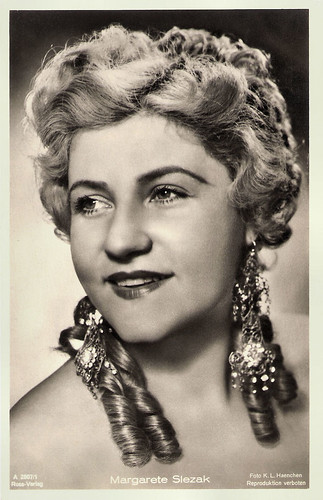
German postcard by Ross Verlag, no. A 2807/1, 1939-1940. Photo: K.L. Haenchen.
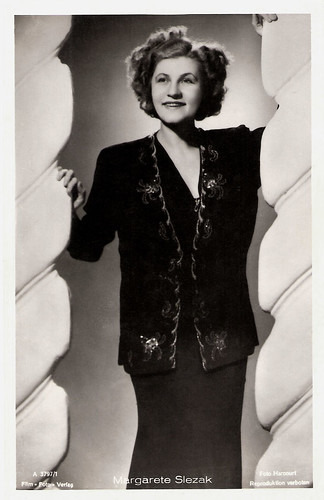
German postcard by Film-Foto-Verlag, no. A 2797/1, 1939-1940. Photo: Harcourt.
Margarete Slezak was born in 1901 in Breslau (now Wrocław, Poland). She was the daughter of the opera singer and film comedian Leo Slezak and actress Elsa (née Wertheim) Slezak. Her brother was the actor Walter Slezak.
Her father trained her soprano voice and had her learn several instruments such as violin and saxophone. When she was ten years old she sang at the choir of the church in Tegernsee, Bavaria.
Her first engagement took her to the Deutsche Staatsoper Berlin from 1930 to 1933 and soon she became a popular opera singer. From 1935 to 1943 she was a member of the ensemble of the Städtischen Opernhauses Berlin-Charlottenburg.
Slezak also appeared in several films. Her debut was the silent film Das Mädel aus der Hödrichsmühle/The girl from the Hödrich mill (Herr Stumfekl, 1928). Among her sound films are the comedy Ich heirate meine Frau/ I Marry My Wife (Johannes Riemann, 1934) with Lil Dagover, and the crime film Der Vorhang fällt/The Curtain Falls (Georg Jacoby, 1939) starring Anneliese Uhlig.
After the Second World War, Slezak appeared in South America and Southeastern Europe. She also sang in Berlin at the Theater des Westens, at the Staatsoper Berlin and in the Wintergarden.
After her father's death in 1946, she managed the Slezak house in Rottach-Egern, where she lived with her husband, the singer Peter Winter. The book Mein Lebensmärchen (My Life's Fairy Tale), which she published in 1947, is a record of her father's memoirs, which she collected in his last months and published on his behalf after his death.
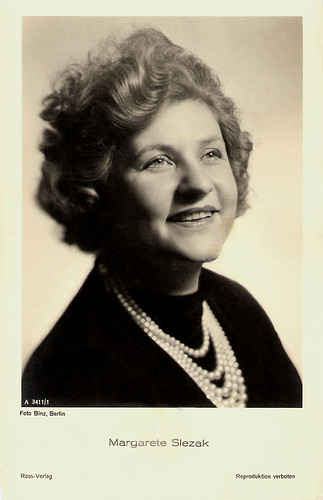
German postcard by Film-Foto-Verlag, no. A 3411/1, 1941-1944. Photo: Tita Binz.
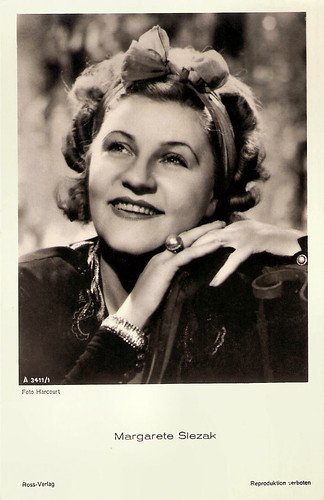
German postcard by Ross Verlag, no. A 3411/1, 1941-1944. Photo: Harcourt.
After the war, Margarete Slezak played a supporting role in the West German sports film Derby (Roger von Norman, 1949) starring Hannelore Schroth and Willy Fritsch. With Fritsch, she also appeared in the historical comedy König für eine Nacht/King for One Night (Paul May, 1950).
Then followed a part in the romantic comedy Des Lebens Überfluss/Abundance of Life (Wolfgang Liebeneiner, 1950) one of the last of the Trümmerfilme (Rubble films) made in the immediate post-war years. It updates a story by Ludwig Tieck to modern-day Hamburg, addressing the shortage of housing in the heavily bombed city.
During the 1950s she played supporting parts in operetta films like Die Csardasfürstin/The Csardas Princess (Georg Jacoby, 1950) starring Marika Rökk and Johannes Heesters, and Die Blume von Hawaii/The Flower of Hawaii (Géza von Cziffra, 1953) featuring Maria Litto.
Her final film was the circus film Keine Angst vor großen Tieren/Not Afraid of Big Animals (Ulrich Erfurth, 1953) starring Heinz Rühmann.
Margarete Slezak died in 1953 in Rottach-Egern, West Germany. After her death her biography Der Apfel fällt nicht weit vom Stamm (The apple does not fall far from the tribe) was published.
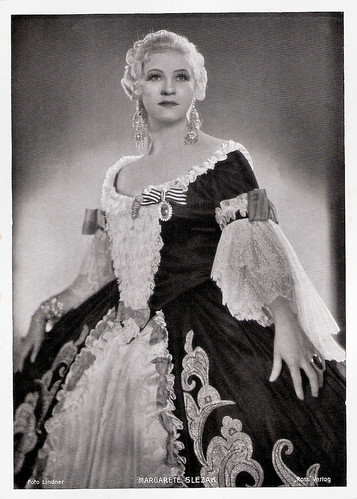
Big German card by Ross Verlag. Photo: Lindner.
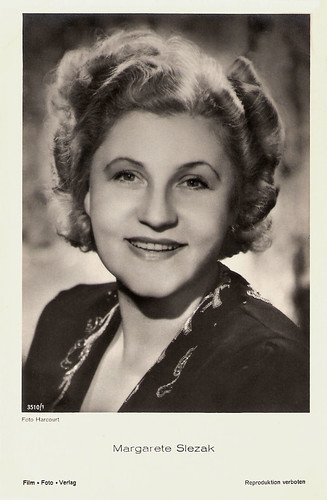
German postcard by Film-Foto-Verlag, no. A 3510/1, 1941-1944. Photo: Harcourt.
Sources: Thomas Staedeli (Cyranos), Filmportal.de, Androom, Wikipedia (German and English), and IMDb.

German postcard by Ross Verlag, no. A 2807/1, 1939-1940. Photo: K.L. Haenchen.

German postcard by Film-Foto-Verlag, no. A 2797/1, 1939-1940. Photo: Harcourt.
Soprano voice
Margarete Slezak was born in 1901 in Breslau (now Wrocław, Poland). She was the daughter of the opera singer and film comedian Leo Slezak and actress Elsa (née Wertheim) Slezak. Her brother was the actor Walter Slezak.
Her father trained her soprano voice and had her learn several instruments such as violin and saxophone. When she was ten years old she sang at the choir of the church in Tegernsee, Bavaria.
Her first engagement took her to the Deutsche Staatsoper Berlin from 1930 to 1933 and soon she became a popular opera singer. From 1935 to 1943 she was a member of the ensemble of the Städtischen Opernhauses Berlin-Charlottenburg.
Slezak also appeared in several films. Her debut was the silent film Das Mädel aus der Hödrichsmühle/The girl from the Hödrich mill (Herr Stumfekl, 1928). Among her sound films are the comedy Ich heirate meine Frau/ I Marry My Wife (Johannes Riemann, 1934) with Lil Dagover, and the crime film Der Vorhang fällt/The Curtain Falls (Georg Jacoby, 1939) starring Anneliese Uhlig.
After the Second World War, Slezak appeared in South America and Southeastern Europe. She also sang in Berlin at the Theater des Westens, at the Staatsoper Berlin and in the Wintergarden.
After her father's death in 1946, she managed the Slezak house in Rottach-Egern, where she lived with her husband, the singer Peter Winter. The book Mein Lebensmärchen (My Life's Fairy Tale), which she published in 1947, is a record of her father's memoirs, which she collected in his last months and published on his behalf after his death.

German postcard by Film-Foto-Verlag, no. A 3411/1, 1941-1944. Photo: Tita Binz.

German postcard by Ross Verlag, no. A 3411/1, 1941-1944. Photo: Harcourt.
One of the last Rubble Films
After the war, Margarete Slezak played a supporting role in the West German sports film Derby (Roger von Norman, 1949) starring Hannelore Schroth and Willy Fritsch. With Fritsch, she also appeared in the historical comedy König für eine Nacht/King for One Night (Paul May, 1950).
Then followed a part in the romantic comedy Des Lebens Überfluss/Abundance of Life (Wolfgang Liebeneiner, 1950) one of the last of the Trümmerfilme (Rubble films) made in the immediate post-war years. It updates a story by Ludwig Tieck to modern-day Hamburg, addressing the shortage of housing in the heavily bombed city.
During the 1950s she played supporting parts in operetta films like Die Csardasfürstin/The Csardas Princess (Georg Jacoby, 1950) starring Marika Rökk and Johannes Heesters, and Die Blume von Hawaii/The Flower of Hawaii (Géza von Cziffra, 1953) featuring Maria Litto.
Her final film was the circus film Keine Angst vor großen Tieren/Not Afraid of Big Animals (Ulrich Erfurth, 1953) starring Heinz Rühmann.
Margarete Slezak died in 1953 in Rottach-Egern, West Germany. After her death her biography Der Apfel fällt nicht weit vom Stamm (The apple does not fall far from the tribe) was published.

Big German card by Ross Verlag. Photo: Lindner.

German postcard by Film-Foto-Verlag, no. A 3510/1, 1941-1944. Photo: Harcourt.
Sources: Thomas Staedeli (Cyranos), Filmportal.de, Androom, Wikipedia (German and English), and IMDb.
No comments:
Post a Comment